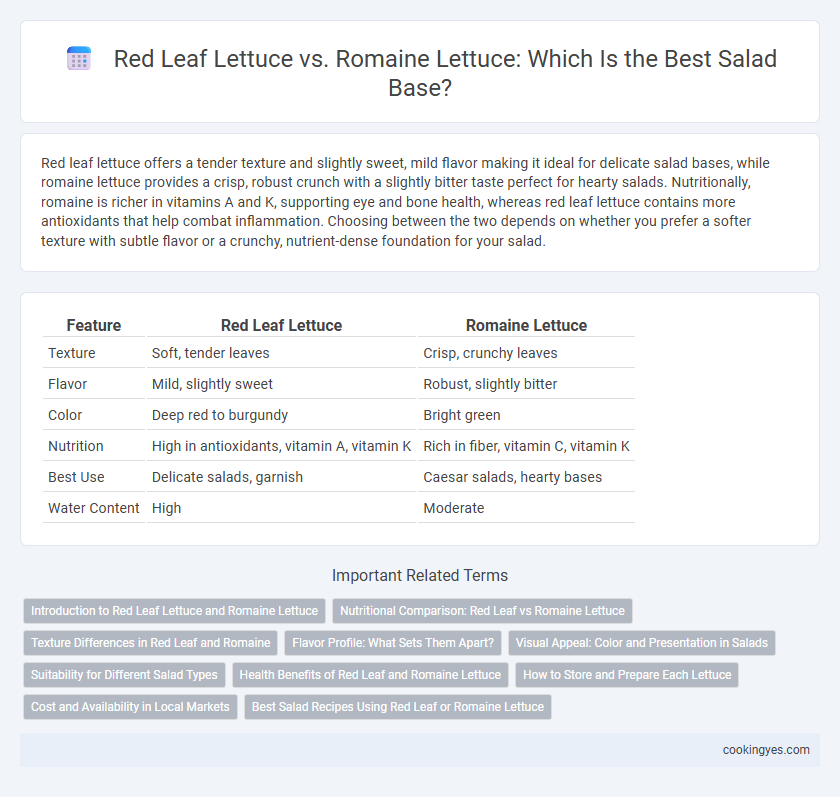Red leaf lettuce offers a tender texture and slightly sweet, mild flavor making it ideal for delicate salad bases, while romaine lettuce provides a crisp, robust crunch with a slightly bitter taste perfect for hearty salads. Nutritionally, romaine is richer in vitamins A and K, supporting eye and bone health, whereas red leaf lettuce contains more antioxidants that help combat inflammation. Choosing between the two depends on whether you prefer a softer texture with subtle flavor or a crunchy, nutrient-dense foundation for your salad.
Table of Comparison
| Feature | Red Leaf Lettuce | Romaine Lettuce |
|---|---|---|
| Texture | Soft, tender leaves | Crisp, crunchy leaves |
| Flavor | Mild, slightly sweet | Robust, slightly bitter |
| Color | Deep red to burgundy | Bright green |
| Nutrition | High in antioxidants, vitamin A, vitamin K | Rich in fiber, vitamin C, vitamin K |
| Best Use | Delicate salads, garnish | Caesar salads, hearty bases |
| Water Content | High | Moderate |
Introduction to Red Leaf Lettuce and Romaine Lettuce
Red Leaf Lettuce features tender, mildly sweet leaves with a deep red hue, offering a delicate texture ideal for fresh salads. Romaine Lettuce provides crisp, sturdy leaves with a slightly bitter flavor, commonly used as a sturdy salad base that holds dressings well. Both varieties deliver essential nutrients like vitamin A and fiber, making them popular choices for healthy salad foundations.
Nutritional Comparison: Red Leaf vs Romaine Lettuce
Red leaf lettuce offers higher levels of antioxidants such as beta-carotene and vitamin E, promoting better skin health, while romaine lettuce provides more vitamin C and folate, essential for immune function and cell repair. Romaine contains nearly twice the amount of vitamin K compared to red leaf, which supports bone health and blood clotting. Both varieties are low in calories and rich in fiber, making them excellent salad bases for weight management and digestive health.
Texture Differences in Red Leaf and Romaine
Red leaf lettuce offers a tender, delicate texture with loosely packed, ruffled leaves that provide a soft bite in salads. Romaine lettuce features a crisp, sturdy texture with firm, elongated leaves that add a satisfying crunch and structural integrity as a salad base. Choosing between red leaf and romaine depends on whether a softer, more pliable texture or a robust, crunchy foundation is preferred for the salad.
Flavor Profile: What Sets Them Apart?
Red leaf lettuce offers a mild, slightly sweet flavor with a tender texture, making it ideal for delicate, fresh salads. Romaine lettuce provides a crisp, slightly bitter taste with a robust crunch, adding a refreshing contrast and heartiness to salad bases. The distinct flavor profiles of red leaf and romaine lettuce cater to different palate preferences, enhancing the overall salad experience.
Visual Appeal: Color and Presentation in Salads
Red Leaf Lettuce offers vibrant burgundy and deep green hues that create an eye-catching contrast, enhancing the visual appeal of any salad base. Romaine Lettuce provides a crisp, bright green palette with a structured, upright leaf shape that adds a clean and elegant presentation. Combining these lettuces can elevate salad aesthetics by balancing rich color variation and texture for a visually appealing dish.
Suitability for Different Salad Types
Red leaf lettuce offers a tender texture and mild flavor ideal for delicate, mixed green salads that highlight fresh ingredients without overpowering them. Romaine lettuce provides a crisp, sturdy base perfect for heartier salads like Caesar or those with chunky vegetables and proteins. Choosing between them depends on the salad's desired texture and structural integrity, with red leaf for light, leafy blends and romaine for robust, crunch-focused dishes.
Health Benefits of Red Leaf and Romaine Lettuce
Red leaf lettuce is rich in antioxidants, vitamins A and K, and supports eye health and bone strength, while romaine lettuce provides high levels of folate, vitamin C, and dietary fiber, promoting heart health and digestive function. Both lettuces are low in calories and packed with essential nutrients that aid in hydration and weight management. Incorporating either red leaf or romaine lettuce as a salad base enhances nutrient intake with unique health benefits tailored to immune support and cardiovascular wellness.
How to Store and Prepare Each Lettuce
Red leaf lettuce should be stored unwashed in a perforated plastic bag in the refrigerator's crisper drawer to maintain its delicate texture and prevent wilting. Romaine lettuce requires similar storage but benefits from being wrapped loosely in a damp paper towel to keep leaves crisp and hydrated. When preparing, red leaf lettuce is best torn by hand to preserve its tender, frilly edges, while romaine is typically chopped to hold its firm structure and crunchy rib for salads.
Cost and Availability in Local Markets
Red leaf lettuce generally costs more than romaine lettuce due to its more delicate leaves and shorter shelf life, impacting frequent restocking in local markets. Romaine lettuce is widely available year-round and often found at lower prices, making it a budget-friendly choice for salad bases. Local market trends show romaine as the preferred option for cost-conscious consumers seeking reliable availability.
Best Salad Recipes Using Red Leaf or Romaine Lettuce
Red Leaf Lettuce provides a tender texture and mild flavor ideal for fresh, vibrant salads featuring fruits and nuts, while Romaine Lettuce offers a crisp crunch and slightly bitter taste perfect for Caesar and Greek salad recipes. Recipes using Red Leaf Lettuce excel when paired with ingredients such as strawberries, walnuts, and goat cheese, highlighting its delicate leaves. Romaine-based salads are enhanced by robust dressings like Caesar or balsamic vinaigrette, anchovies, and parmesan, emphasizing its sturdy structure and nutritional density.
Red Leaf Lettuce vs Romaine Lettuce for Salad Base Infographic

 cookingyes.com
cookingyes.com